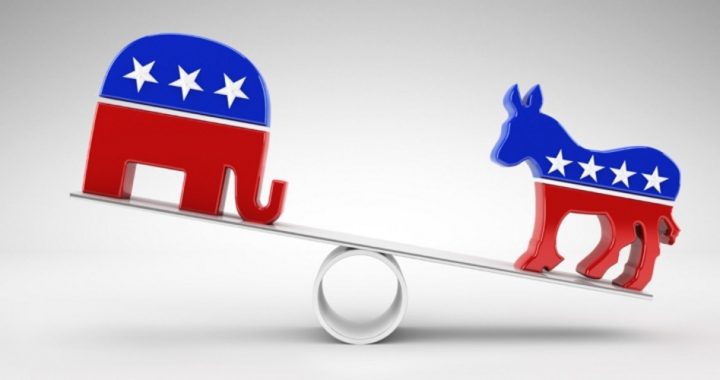
Liberals may cheer while conservatives view it as a bit like Invasion of the Body Snatchers, but for sure is that Republicans are outnumbered on the political battlefield. In fact, the Democrats’ huge lead in party registration figures could spell trouble for the GOP in the fall, says an expert. As the Washington Examiner reports:
Democrats hold a massive voter lead in states that require party registration, a gap of 12 million that could be key to whether the party takes control of the House and Senate in the fall midterm congressional elections, according to a new analysis.
Overall, 40 percent of voters in 31 party registration states are Democrats, 29 percent are Republicans, and 28 percent are independents, according to a new report of July numbers from the University of Virginia’s Center for Politics. The states include several with key battles over House seats such as California, New York, Florida, and Pennsylvania.
The lead is significant, said Rhodes Cook’s analysis in Center Director Larry Sabato’s “Crystal Ball” newsletter, because in the past presidential election the majority party in 24 of the 31 states won, especially among Republican states.
So is it midterm game over, GOP? Not so fast, says Rhodes Cook, writing, “Certainly there are facts that argue that they should be taken with a grain or two of salt. Most party registration states are found in more Democratic terrain: the Northeast (11 states plus the District of Columbia) and the West (10 states), followed by the South (six states) and the Midwest (four states), all of the latter rural states west of the Mississippi River.”
“To be sure, there are a number of major states that do not register voters by party, such as Texas, Georgia, Washington, and the keystones of the industrial Midwest: Illinois, Indiana, Michigan, Ohio, and Wisconsin. If they did register by party, Texas, Georgia, and Indiana would almost certainly add to the Republican total; the industrial states probably less so,” Cook continues.
Yet this understates the issue. Note that California (3.7 million Democrat registration advantage {DRA}), New York (three million DRA), Maryland (1.1 million DRA), Massachusetts (one million DRA), and New Jersey (almost one million DRA) account for approximately 9.8 million of the 12 million overall DRA — more than 81 percent of it. Add in solidly Democrat Connecticut, Delaware, and D.C., and the figure rises to 10.5 million — based on just eight states (see chart here).
Why is this significant? California and New York are Democrat strongholds and are, respectively, the first and fourth most populous states, and all these leftist states together account for approximately 87 million of the U.S.’s 328 million population. Moreover, their DRA is largely attributable to lopsided numbers in their big cities, which no one expects Republicans to win, anyway.
The point? This blue-zone DRA certainly means Democrats will win many urban districts by 60-plus percent, but whether that figure or one percent, it’s still only one congressional seat. As for Senate races, the seven states (D.C. has no Senate representation) already have only Democrat senators — the GOP has nothing to lose.
Yet there’s more. A DRA also exists in very red Kentucky, Louisiana, and West Virginia. This is probably due to what I’ve called “ethnic Democrats,” people (likely older) who thus registered based on family tradition, many of whom now vote consistently Republican due to the Democrats’ growing leftist radicalism. There won’t be any “blue wave” in these states, and adding their DRA numbers to those of the aforementioned blue states brings the total to more than 11.3 million — almost all of the nationwide DRA figure of 12 million.
Another major factor is the recent years’ growth in independents, which means that “many voters seem to be saying to the two major parties: ‘a pox on both your houses,” writes Cook.
A good example of this may be the anti-establishment Donald Trump phenomenon, where in 2016, the president “won 11 of 12 majority Republican states, and took six of 19 Democratic states,” relates the Washington Examiner.
These realities, along with the waxing Maxine Waters (D-Calif.) wing of the Democrats’ encouraging of socialism, violence, and the abolition of ICE, may very well mean it’ll be the Democrats singing the November blues.
But that’s the short term. The longer one is being shaped not only by the inculcation of leftist ideology (and the vice paving the way for it) via academia, the media, and entertainment, but by the Democrats’ great get-in-the-vote drive.
It’s called (im)migration.
Ever since 1968, 85 to 90 percent of our (im)migrants have hailed from the Third World, and 70 to 90 percent of them vote Democrat upon naturalization. This is the real reason leftists love immigration: It’s a surefire way they can make their DRA explode as they gradually effect the Californification of the whole nation.
The truth is that since we face a world comprised largely of de facto socialists, eliminating their importation is imperative. The alternative is Third World-wave immigration designed, as a British leftist admitted in 2009, “to rub the Right’s nose in diversity and render their arguments out of date.” The choice is ours.
Photo: SilverV/iStock/Getty Images Plus



